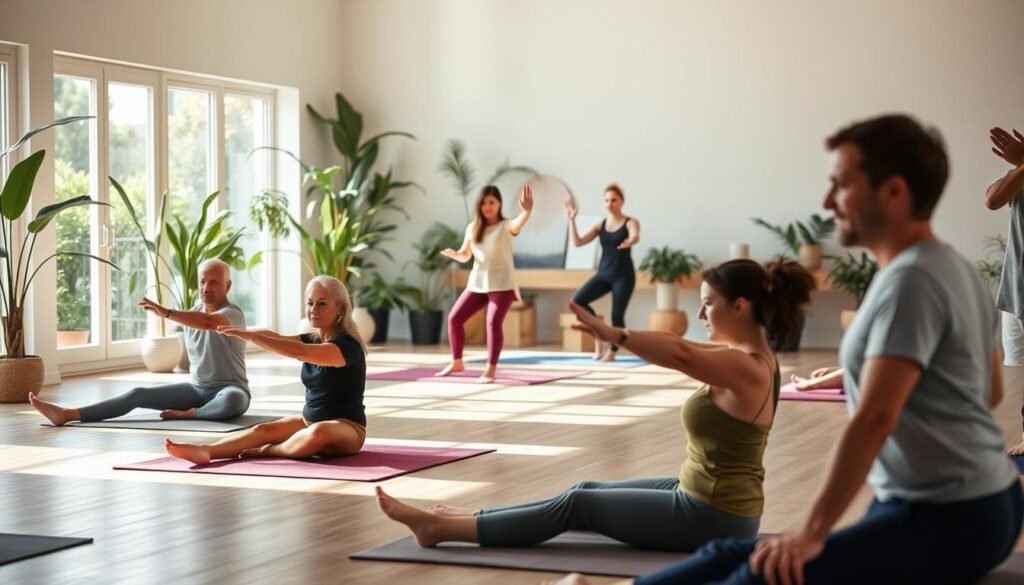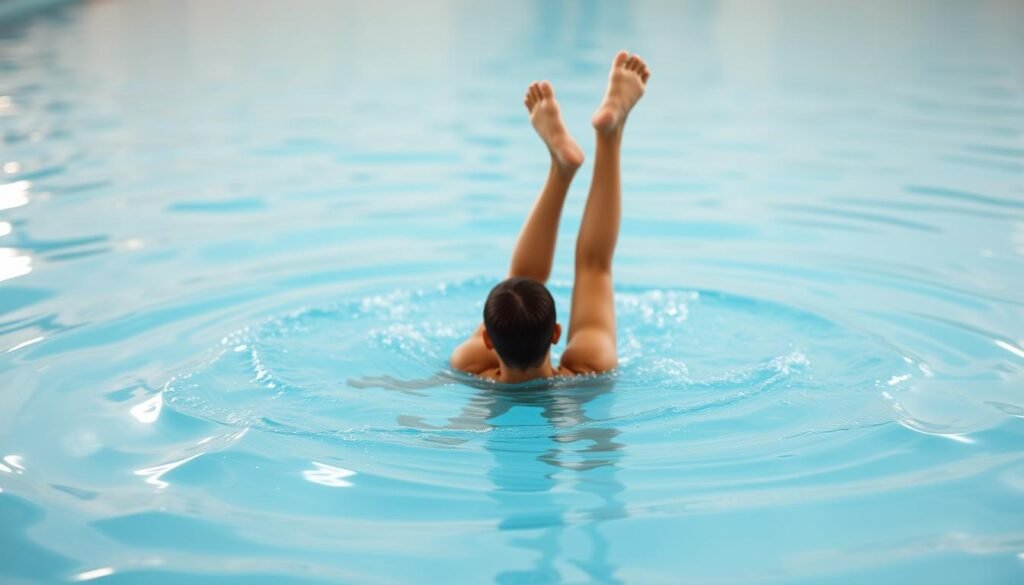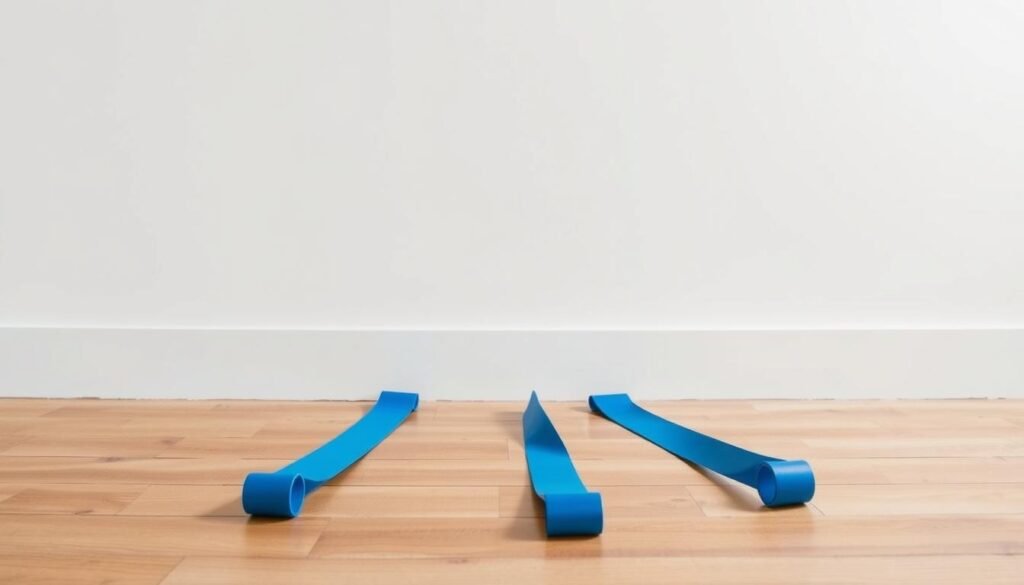The Best Low-Impact Workouts for Joint Pain Relief

This guide introduces gentle training options that cut pounding forces while still building strength and stamina. You’ll learn how these approaches protect sensitive joints by reducing impact, boosting synovial fluid circulation, and strengthening muscles that support movement patterns.
We preview land, water, and mind-body choices like walking, cycling, swimming, yoga, Pilates, tai chi, and seated moves. The practical tips cover warm-ups, proper form, gradual progress, and cooling down so you can limit flare-ups and keep a steady routine.
Beyond physical steps, stress management and mindfulness affect how people perceive pain and stick with a plan. Look to trusted resources such as the WHO mental health overview, APA guidance on managing stress, and Psychology Today’s primer on mindfulness to support your approach.
Key Takeaways
- Gentle options cut pounding forces while still delivering cardio and strength benefits.
- Targeted moves encourage lubrication, stability, and better mobility for daily life.
- Include land, water, and mind-body choices to match ability and goals.
- Warm up, use correct form, and progress slowly to avoid flare-ups.
- Weight control and stress management both influence knee load and adherence.
Why Low-Impact Exercise Eases Joint Pain and Builds Resilience
Choosing gentler forms of activity reduces the force sent through cartilage and connective tissue. This helps people with knee osteoarthritis or past injuries stay active with fewer flare-ups.
Gentle resistance and range of motion work strengthen the muscles that support alignment. Stronger muscle scaffolding improves posture and daily movement. It also encourages joint lubrication and better flexibility over time.
Small bouts of activity burn calories and can help with weight control. Less weight means less load on knees and hips, which often eases symptoms for many adults.
- Limits repetitive pounding while still building support around vulnerable areas.
- Improves neuromuscular control, balance, and mobility without jarring impacts.
- Pairs well with stress-management and mindfulness to lower pain perception and boost consistency (see APA and Psychology Today for coping skills).
| Benefit | How it Works | Common Examples |
|---|---|---|
| Reduce joint load | Less force through cartilage | Walking, cycling |
| Build support | Gentle resistance boosts muscle | Resistance bands, Pilates |
| Improve mobility | Range-of-motion and lubrication | Swimming, yoga |
| Increase resilience | Short, frequent sessions add capacity | Tai chi, seated routines |
Low-Impact Workouts, Joint Pain Relief Exercises You Can Start Today
Start with steady, manageable activities that strengthen support muscles and boost endurance. These choices build bone-loading benefits and improve range of motion while keeping stress on the body low.

Walking for weight-bearing strength and mobility
Walking is a simple, weight-bearing option that supports bone density and firms muscles around the hips, knees, and ankles.
Begin with short, easy sessions in the cool morning or evening. Add minutes slowly and watch how your knees and hips feel afterward.
Cycling and stationary bike for knee- and hip-friendly cardio
Cycling—either on a bike path or a stationary bike—builds leg strength and supports cardiovascular health with minimal joint stress.
Set saddle height so your knee has a slight bend at the bottom of the pedal stroke. Good form reduces irritation and increases comfort.
Elliptical training to mimic running without the impact
The elliptical provides a smooth, guided stride that mimics running while cutting ground reaction forces.
Use it during flare-ups or when rebuilding endurance. Keep sessions conversational in intensity and increase duration gradually.
- Alternate walking and cycling days to vary muscle demand.
- Choose flat paths, treadmills, or tracks if uneven terrain causes discomfort.
- Track time and perceived effort instead of speed to safeguard range of motion and progress safely.
| Activity | Main Benefits | Quick Tips |
|---|---|---|
| Walking | Bone loading, mobility, leg strength | Start slow, add minutes, cooler hours reduce swelling |
| Cycling / Stationary bike | Builds quads, hamstrings, cardiovascular health | Adjust saddle height; knees track mid-foot with slight bend |
| Elliptical | Cardio without impact; lower-body conditioning | Keep intensity conversational; increase time in small steps |
Make a Splash: Water-Based Options That Leverage Buoyancy
Glide into the pool to use buoyancy as a tool for movement that spares sore knees and hips. Water supports most of your body weight, so impact drops while you keep moving. That makes the pool ideal for flare-ups or steady cross-training.

Swimming to reduce joint stress while training the full body
Swimming gives multi-directional resistance that tones muscles evenly and builds cardio without heavy loading. Short laps with mixed strokes improve range of motion and help stiffness fade.
Water aerobics for gentle resistance and arthritis-friendly movement
Water aerobics classes use drag to add resistance while keeping the environment friendly for arthritis. Group sessions boost circulation, balance, and muscle endurance with minimal strain.
Form tips in the pool to protect shoulders, hips, and knees
Keep a neutral neck and spine, use short controlled kicks, and favor smooth breathing. Tools like kickboards and pull buoys let you target legs or upper body safely. Start with short intervals and build time as comfort improves.
| Option | Main Benefit | Quick Tip |
|---|---|---|
| Lap swimming | Full-body strength, cardio | Mix strokes; keep steady pace |
| Shallow-water aerobics | Gentle resistance, balance | Use water drag; follow instructor |
| Pool walking / step-ups | Leg strength without load | Start shallow; increase duration |
| Tool-assisted sets | Targeted muscle focus | Pull buoy for arms; board for legs |
Mind-Body Movements That Boost Flexibility, Balance, and Calm
Mind-body practices link gentle movement with breath to boost balance, flexibility, and calm. These activities teach alignment and posture while building usable strength without jarring motion.

Yoga for alignment, posture, and joint-friendly strength
Yoga uses weight-bearing poses that support bone density and posture. Start with alignment-focused sequences and props like blocks or straps to keep ranges comfortable.
Pilates for core stability and reduced joint strain
Pilates trains the core and spinal neutrality. Short, precise sets help offload compensating muscles and improve daily movement quality.
Tai chi for balance, coordination, and fall prevention
Tai chi links slow transitions with steady breathing to boost balance and coordination. Older adults often see fewer falls after regular practice.
Mindfulness and breathwork to reduce stress-related pain perception
Slow, deliberate breathwork calms the nervous system and can reduce stress that amplifies perceived pain. Try brief breathing before and after sessions to improve focus and adherence.
- Choose yoga flows that prioritize alignment and mobility with props.
- Use Pilates to reinforce core support and spinal alignment.
- Add tai chi to enhance balance and body awareness through gentle transitions.
- Pair movement with mindfulness—see NIMH, Psychology Today, WHO, and APA guidance for stress and mental health resources to support long-term practice: https://www.nimh.nih.gov/health/topics/anxiety-disorders/index.shtml, https://www.psychologytoday.com/us/basics/mindfulness, https://www.who.int/news-room/fact-sheets/detail/mental-health-strengthening-our-response, https://www.apa.org/topics/stress/managing.
Strength Without Strain: Low-Impact Resistance and Core Work
Build usable strength without strain by focusing on targeted resistance and steady core work.

Resistance bands to build support around knees and hips
Resistance bands give scalable tension to strengthen muscles that protect knees and hips. Use light-to-moderate bands for clamshells, lateral walks, glute bridges, and terminal knee extensions.
Focus on smooth tempo and full range. Clean repetitions with stable alignment increase muscle control and limit discomfort. Pair two to three band movements into a short circuit for efficient results.
Chair-based and wall-supported moves for limited mobility
Chair-based options like seated marches, seated leg lifts, and strap-assisted hamstring stretches build capacity without heavy loading. These are ideal after procedures or during early rehab.
Wall-supported moves—wall squats and wall push-ups—help maintain form and reduce balance demands. Keep the core engaged and progress resistance slowly to improve mobility and durability.
| Option | Main Target | Quick Tip |
|---|---|---|
| Band hip abduction | Glute stabilizers | Use light band; 10–15 controlled reps |
| Seated knee extensions | Quadriceps | Slow tempo; avoid locking the knee |
| Wall squat | Quads + core | Short hold; keep knees behind toes |
| Seated marches | Hip flexors, core | Controlled pace; breathe steadily |
- Progress resistance gradually; do not chase fatigue.
- Track how joints feel 24 hours after sessions; reduce load if discomfort persists.
- Combine these moves with walking or cycling on alternate days to build balanced capacity.
Start Smart: Technique, Pacing, and Safety for Sensitive Joints
Begin each session by warming the body and tuning alignment to make movement safer and more sustainable. Gentle cardio and joint mobilizations raise circulation and ease stiffness. Follow this with posture cues to protect sensitive joints during activity.
Proper form, warm-ups, and gradual progression to prevent flare-ups
Start with 5–10 minutes of easy movement to prepare tissues and reduce stiffness. Reinforce form cues—neutral spine, soft knees, and steady breathing—so you load structures correctly.
Progress slowly. Add 5–10 minutes every few sessions or a couple of reps at a time. Use a simple pain scale during and after activity; stop if sharp pain appears and rest until soreness eases.
How much is enough? Building toward 150 minutes per week
Aim for 150 minutes of light-to-moderate activity spread across the week. Divide time among walking, cycling, swimming, or mind-body sessions to vary demand on tissues.
If you have recent injuries, inflammatory flares, or complex conditions, check in with a healthcare provider before increasing load. Ask a healthcare provider about tailored progressions after surgery or if swelling is unexplained.
- Session start: 5–10 minutes easy movement, then alignment cues.
- Progress: Small time blocks or extra reps—avoid jumping to long sessions.
- Rotate activities: Change focus each day to reduce overload and keep training fresh.
- Recovery: Gentle stretching, hydration, and sleep support tissue repair and lower stress.
- Digital support: Use apps or trackers to log minutes and notes; digital tools can boost adherence (see JMIR on adherence).
| Focus | Why it matters | Quick action |
|---|---|---|
| Warm-up | Raises circulation and mobility | 5–10 min easy cardio + joint circles |
| Form cues | Protects alignment and range motion | Neutral spine, soft knees, steady breath |
| Progression | Limits setbacks and builds capacity | Add 5–10 min or a few reps every 3–5 sessions |
| Medical check | Tailors plan for injuries or complex conditions | Consult your healthcare provider before big increases |
Helpful links: mental health and adherence resources from JMIR, WHO, and APA can guide stress and habit support: https://mental.jmir.org/2024/1/e60589, https://www.who.int/news-room/fact-sheets/detail/mental-health-strengthening-our-response, https://www.apa.org/topics/stress/managing.
Lifestyle Levers That Support Joint Relief and Consistency
Small daily habits outside the gym shape sleep, stress, and how easily you stick with movement.
Stress management and digital detox to lower tension and improve sleep
Brief mindfulness, breathwork, and tech-free windows lower stress and can reduce how much discomfort you notice. Try short breathing sessions and a nightly screen curfew to improve sleep quality.
See APA guidance on stress management and psychology resources for mindfulness techniques (https://www.apa.org/topics/stress/managing; https://www.psychologytoday.com/us/basics/mindfulness).
Nutrition for joints: protein, anti-inflammatory eating, and healthy weight
Center meals on lean protein, legumes, fish, and dairy or fortified alternatives to support muscle repair and maintain weight. Favor colorful plants, whole grains, nuts, and olive oil for anti-inflammatory benefit.
Public health and nutrition resources: Harvard Nutrition Source on protein and CDC guidance for chronic conditions (https://www.hsph.harvard.edu/nutritionsource/what-should-you-eat/protein/; https://www.cdc.gov/diabetes/managing/eat-healthy.html).
Healthy longevity habits inspired by Blue Zones
Adopt routines seen in long-lived communities: regular incidental movement (walking, gardening), strong social ties, and a clear sense of purpose. These habits support a higher quality life and steady adherence to activity.
For more, see AICR and reviews of Blue Zones dietary patterns (https://www.aicr.org/resources/blog/can-the-blue-zone-diet-help-you-live-longer/).
Using digital tools wisely to support mental health and exercise adherence
Use apps selectively to track minutes, log symptoms, and set gentle reminders. Pair tracking with mental health resources so tools support motivation without increasing stress.
Evidence on digital engagement and mental health tools is available from JMIR and WHO (https://mental.jmir.org/2024/1/e60589; https://www.who.int/news-room/fact-sheets/detail/mental-health-strengthening-our-response).
| Focus | Why it helps | Practical step |
|---|---|---|
| Stress control | Reduces perceived discomfort and improves sleep | 5 min breathing + 30-min tech-free evening |
| Protein & anti-inflammatory diet | Supports muscle repair and lower inflammation | Include lean protein + plant-forward plate at meals |
| Blue Zones habits | Encourages natural movement and social support | Daily walk, garden, or community activity |
| Smart digital use | Boosts adherence without adding stress | Limit notifications; use trackers for trends only |
Your Joint-Friendly Weekly Game Plan
Build a weekly plan that mixes gentle cardio, short strength sessions, and calming movement to keep you active without setbacks.
Aim for 3 cardio sessions per week. Choose walking, cycling, or swimming for 15–30 minutes at an easy-to-moderate pace to support cardiovascular health and stamina.
Add 2 short resistance sessions of 10–20 minutes. Use bands, chair-based moves, or wall-supported sets to strengthen muscles around the knees and hips without overloading them.
Include 2 mobility and balance blocks such as yoga or tai chi. These 10–20 minute sessions improve flexibility, coordination, and stability for daily tasks.
Tip: Schedule one pool-based day—swimming or water aerobics—when soreness rises. The pool keeps time on your program while easing load on sensitive joints.
When balance is a concern, pick a stationary bike for predictable motion. Alternate bikes and outdoor walks to keep variety and enjoyment.
| Day | Main Focus | Time | Notes |
|---|---|---|---|
| Monday | Cardio (walking or bike) | 15–25 min | Easy pace; conversational effort |
| Tuesday | Resistance mini-session | 10–20 min | Bands or chair moves; focus on form |
| Wednesday | Mind-body (yoga / tai chi) | 15–20 min | Mobility and balance emphasis |
| Thursday | Pool session | 15–30 min | Swimming or water aerobics on sore days |
| Friday | Cardio (cycle or walk) | 15–30 min | Stationary bike if balance is a concern |
| Saturday | Resistance mini-session | 10–20 min | Progress reps slowly; check how knees feel |
| Sunday | Active recovery | 10–20 min | Light walk and gentle stretching |
Track total weekly time and spread sessions across days that fit your routine. Multiple short bouts add up and support steady progress.
Adjust volume based on how your knees and other joints feel. Prioritize consistency and gradual increases in time over pushing intensity.
Conclusion
Finish by building a steady routine that blends gentle movement, strength, and recovery habits. Low-impact exercises can cut mechanical load while you gain flexibility and functional strength for daily life.
Keep sessions short when needed and rotate land, pool, and mind-body options such as tai chi to protect your joints and avoid setbacks. Track comfort, refine form, and increase time slowly.
Support the plan with healthy weight, protein-rich meals, and stress tools to improve adherence. For mental health and coping, see WHO, APA, Psychology Today, and digital support research (https://www.who.int/news-room/fact-sheets/detail/mental-health-strengthening-our-response; https://www.apa.org/topics/stress/managing; https://www.psychologytoday.com/us/basics/mindfulness; https://mental.jmir.org/2024/1/e60589).
If you manage complex conditions or past injuries, consult a clinician to tailor progressions. With smart pacing, varied options, and lifestyle supports, you can reduce discomfort, build capacity, and enjoy better quality of movement over time.





